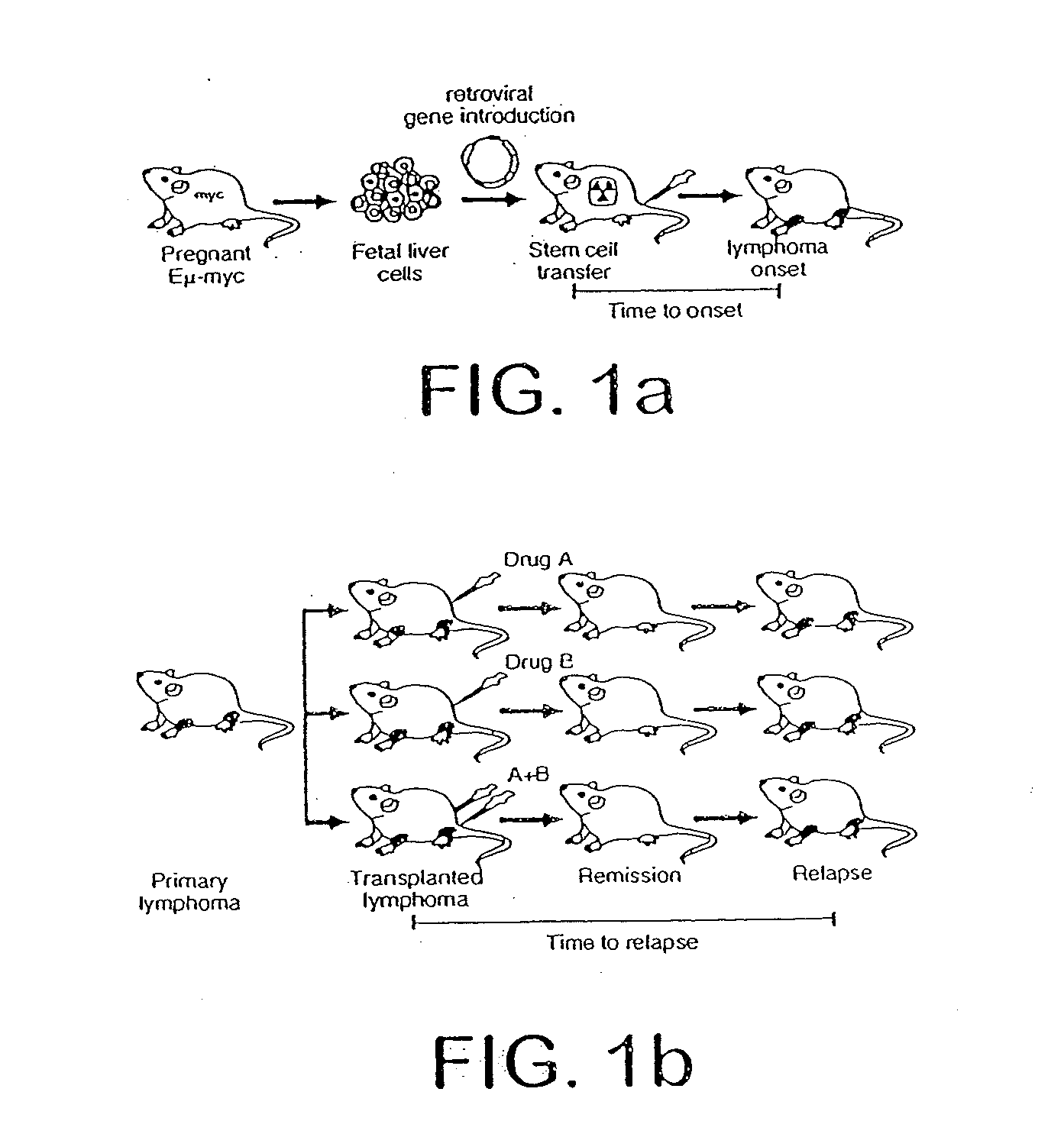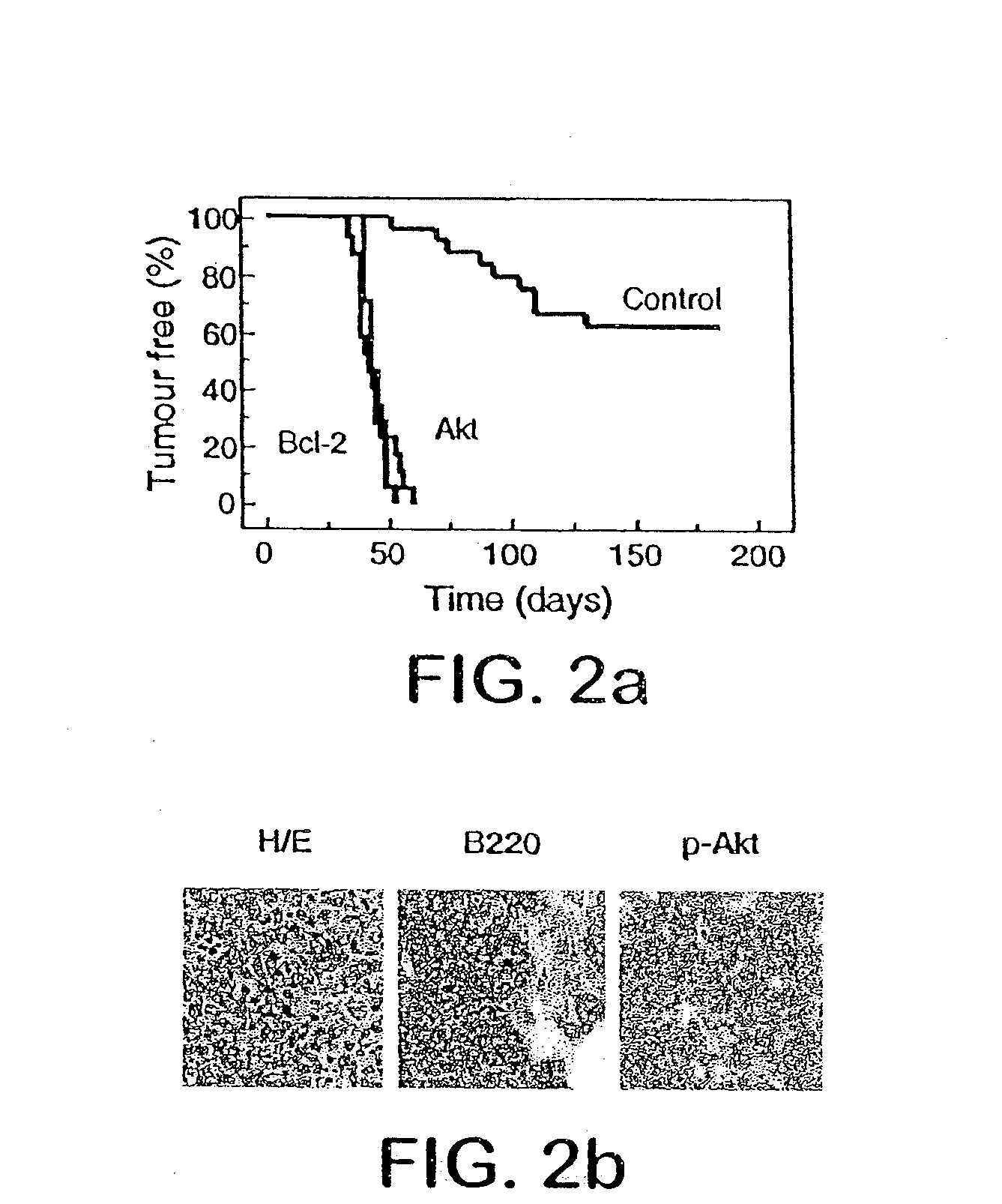Model for studying the role of genes in chemoresistance
- Summary
- Abstract
- Description
- Claims
- Application Information
AI Technical Summary
Benefits of technology
Problems solved by technology
Method used
Image
Examples
example 1
Generation of Eμ-myc Lymphoma with Defined Genetic Alterations
[0176]Lymphoma cells with defined genetic alterations were generated according to published procedures (see, e.g., Schmitt, C. A., et al., Cancer Cell, 1(3):289-298, (2002)). Briefly, day 13.5-18.5 pregnant mice from an Eμ-myc-transgenic to wild-type (C57BL / 6) cross were sacrificed to obtain fetal livers, which were minced and grown at approximately 3×106 cells / ml in conditions supporting hematopoietic stem cell (HSC) growth (37% DMEM, 37% Iscove's modified Dulbecco's Medium [Gibco], supplemented with 20% fetal calf serum, 2% L-glutamine [200 mM], 100 U / ml penicillin / streptomycin, 5×10−5 M 2-mercaptoethanol, 4% 0.45 μm filtered WEHI-3B supernatant, 0.2 ng / ml recombinant murine interleukin-3, 2 ng / ml recombinant murine interleukin-6, and 20 ng / ml recombinant murine stem cell factor [all cytokines from Research Diagnostics] at 37° C. in a humidified 5% CO2 atmosphere).
[0177]Eμ-myc / p53+ / −HSCs were derived from crosses of E-m...
example 2
Tumor Free Survival of Akt-Expressing Mice and Response of Secondary Tumors to Combination Therapy
[0187]Parent vector pMSCV-IRES-GFP, or derivative vectors pMSCV-Akt-IRES-GFP or pMSCV-Bcl-2-IRES-GFP were used to transduce hematopoietic stem cells obtained as described above. Irradiated recipient mice were administered the transduced hematopoietic stem cells as described above. The scheme is presented in FIG. 1A.
[0188]Stem cells were infected using retroviral vectors (either pMSCV-IRES-GFP as control, pMSCV-Akt-IRES-GFP or pMSCV-Bcl-2-IRES-GFP). When primary tumors arose in these animals, the mice were sacrificed and the tumors were harvested and injected into five recipient mice. Following injection of 106 cells into the tail vein, upon development of palpable (secondary) tumors (ca. 3 weeks following the iv injection), mice were treated with either adriamycin (10 mg / kg in H2O, once, by i.p. injection) or rapamycin (4 mg / kg by i.p. injection) and adriamycin (d1 rapamycin, d2 both dr...
example 3
Variations in Response to Treatment on Identical Tumors
[0194]Primary tumors were produced as described above. Identical primary tumors were injected into 5 recipient animals, thus forming cohorts of mice carrying identical tumors. The treatment regimens of 7 primary Akt tumors (#135, #136 etc.) injected into multiple recipient mice were analyzed as a matched group in which identical secondary tumors received different treatments. The treatments were: adriamycin, rapamycin and the combination rapa-adr (schedule as above in Example 2); the treatment shown in FIG. 7 as adr-rapa is adriamycin and rapamycin given on day 1, days 2-5 rapamycin alone at the previous doses by i.p. injection. Mice were monitored twice weekly by palpation and blood smears. The graph indicates the individual tumor free survival times, as time to relapse measured in days. If the mice were never tumor free, time to relapse is scored as ‘0’ days.
PUM
| Property | Measurement | Unit |
|---|---|---|
| Electrical resistance | aaaaa | aaaaa |
| Chemotherapeutic properties | aaaaa | aaaaa |
| Hyperproliferative | aaaaa | aaaaa |
Abstract
Description
Claims
Application Information
 Login to View More
Login to View More - R&D
- Intellectual Property
- Life Sciences
- Materials
- Tech Scout
- Unparalleled Data Quality
- Higher Quality Content
- 60% Fewer Hallucinations
Browse by: Latest US Patents, China's latest patents, Technical Efficacy Thesaurus, Application Domain, Technology Topic, Popular Technical Reports.
© 2025 PatSnap. All rights reserved.Legal|Privacy policy|Modern Slavery Act Transparency Statement|Sitemap|About US| Contact US: help@patsnap.com



